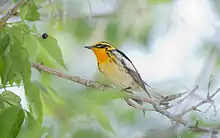Anna Blackburne
Anna Blackburne (baptised Anne Blackburne; 1726 – 30 December 1793) was an English naturalist who had an extensive collection of natural history specimens and corresponded with several notable naturalists of her era. Blackburne was born at Orford Hall, Orford, Warrington, Lancashire, into a family of landowners and merchants. After her mother's death, she lived at Orford with her father John Blackburne, who was known for his interest in botany and his hothouses for exotic plants. John Blackburne also had an extensive library where Anne likely studied botany; she later learned Latin to read the Systema Naturae of Carl Linnaeus. Blackburne collected insects, shells, minerals and birds. She regularly met with the naturalist Johann Reinhold Forster while he was teaching at Warrington Academy. Forster instructed her in entomology and helped with her insect collection.
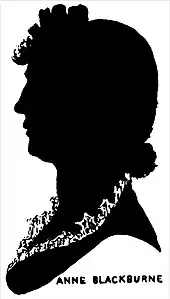
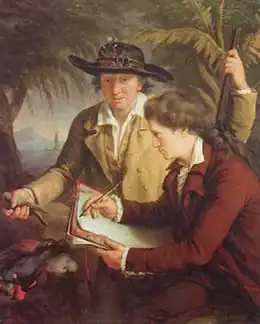
Blackburne corresponded with other naturalists including Linnaeus, to whom she sent a box of birds and insects. Her brother Ashton, who lived in New York, sent her specimens of North American birds. Thomas Pennant studied these birds in Blackburne's collection and included them in his book Arctic Zoology. Another source for Blackburne's collection was her exchange with Peter Simon Pallas in St. Petersburg, from whom she obtained mostly plants, birds, and minerals.
After her father's death, Blackburne and her museum moved to nearby Fairfield Hall. After her 1793 death, her nephew John Blackburne inherited the collection. Several species are named after Blackburne, including the beetle Geotrupes blackburnii, the Blackburnian warbler and the Blackburnia pinnata, now called Zanthoxylum pinnatum.
Family background and early life
Blackburne was born in 1726 at Orford Hall, Warrington, as the fifth of nine children of John Blackburne (1693–1786) and Katharine Ashton or Assheton (1701–1740).[1][2][lower-alpha 1][lower-alpha 2] Her maternal grandfather was William Assheton, Rector of Prestwich.[6] She was baptised as "Anne" on 3 January 1726, but was usually known as "Anna".[7][8][9] Her family were landowners who had lived at Orford Hall since 1638.[10] They also owned merchant ships, were involved in trade with Russia, and produced salt in Cheshire and at Salthouse Dock in Liverpool.[11] John Blackburne was interested in botany and had a large collection of plants in his garden. In his coal-fired hothouses, he grew exotic plants including pineapples and cotton. Some of this cotton was noted to have been made into a muslin dress for his daughter.[9][12] Little is known about Anna's formal education,[2] but she may have used the natural history books in her father's library to study botany during her childhood.[13] In the years following her mother's death, Anna's surviving siblings left Orford Hall; eventually, only Anna and her father remained.[2] Her brother John was a businessman who served as mayor of Liverpool in 1760–61 and was involved in the slave trade before 1758;[14] her brother Ashton lived in New York,[9] from where he sent bird specimens to his sister.[15] Anna Blackburne eventually became the mistress of the manor and referred to herself as "Mrs. Blackburne" although she never married; the title "Mrs." was customarily used also by unmarried ladies of the 18th century.[2]
Association with other naturalists
Blackburne was keenly interested in natural history. She was in contact with several well-known naturalists, and some of them visited her and her father at Orford Hall.[8][16] She learned Latin and studied the Systema Naturae of Linnaeus.[17] Occasionally, Blackburne visited London and Oxford;[18] on one such visit to the botanical garden at Oxford, she debated with the gardeners and surprised the bystanders with the extent of her botanical knowledge.[19] She collected various natural history specimens including insects, shells, minerals and birds.[8] In the early years of her collection, she obtained most of her specimens from her widely travelled family members.[20]
Johann Reinhold Forster
One of the naturalists who visited the Blackburnes was Johann Reinhold Forster, who in 1767 had been appointed as tutor in modern languages and natural history at Warrington Academy as the replacement to Joseph Priestley.[21] Forster's scientific lectures at Warrington covered biology, entomology and mineralogy.[22] In 1768, Forster dined at Orford Hall every Saturday, helped Blackburne with the arrangement of her insect collection, and presented his lectures on entomology to her.[22][23] Blackburne allowed Forster to use the family's library,[24] and encouraged him to publish his work.[25][22] For his friend Thomas Pennant, another naturalist, Forster unsuccessfully tried to obtain duplicates of shells in her collection.[22] Until he moved to London in 1770, Forster and Blackburne had a mutually beneficial relationship. While she received education, he benefitted from their social relationship and her library. Forster even expected Blackburne to order books for him.[26][24]
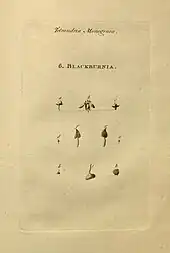
Forster later took part in the second voyage of James Cook as the expedition's naturalist.[27][28] After his return, he and his son Georg published some of the botanical results of the voyage in the book Characteres generum plantarum.[29] Anna Blackburne received one of the small number of folio copies, which were given by the Forsters as presents to royalty as well as friends and supporters.[30][lower-alpha 3] Forster dedicated one genus to Blackburne and her father, Blackburnia, including Blackburnia pinnata, now called Zanthoxylum pinnatum.[32] In the dedication, Forster mentioned John's garden and Anna's collections, thanking both for allowing him to use their "most informative museum".[8]
Carl Linnaeus
On 29 June 1771, Blackburne wrote to the Swedish botanist and zoologist Carl Linnaeus, offering to send him "a few Birds & insects" collected by her brother Ashton near New York.[33] Linnaeus thanked her in his reply, written in Latin, and promised to name a new species after her if she gave him an unknown specimen.[34] In response, Blackburne sent "a small box containing a few Birds and insects".[19] These three letters are all that is known of their correspondence. The claims in her obituary that Blackburne was a "friend and constant correspondent of Linnaeus" or that he named a plant after her are inaccurate.[5][35] Linnaeus's student Johan Christian Fabricius visited Orford Hall, where he examined her collection of insects, and found a new species of beetle. He called it Scarabaeus blackburnii; it is now called Geotrupes blackburnii.[18]
Thomas Pennant
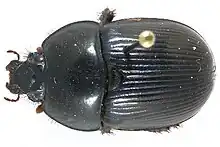
The naturalist Thomas Pennant, who had been aware of Blackburne and her collections through correspondence with Forster since at least 1768, visited Orford Hall in May 1772.[15] He later described the visit in his 1774 book, A Tour in Scotland, and Voyage to the Hebrides, where he praised John Blackburne's botanical collections and noted about Anna, "Mrs. Blackburne his daughter extends her researches still farther, and adds to her empire another kingdom; not content with the botanic, she causes North America to be explored for its animals, and has formed a museum from the other side of the Atlantic, as pleasing as it is instructive."[36][15] Pennant studied the collection of birds that Blackburne's brother Ashton had sent to her from America, which resulted in him including more than a hundred species of birds from New York alone in his book Arctic Zoology.[15][37] The book's preface contained extensive thanks to the Blackburnes for their contribution:[15]
To the rich museum of American Birds, preserved by Mrs. Anna Blackburn, of Orford, near Warrington, I am indebted for the opportunity of describing almost every one known in the provinces of Jersey, New York, and Connecticut. They were sent over to that lady by her brother the late Mr. Ashton Blackburn; who added to the skill and zeal of a sportsman, the most pertinent remarks on the specimens he collected for his worthy and philosophical sister.
— Thomas Pennant, Arctic Zoology, 1784[38]
Pennant named the Blackburnian warbler in honour of Anna Blackburne.[39] In 1975, V. P. Wystrach determined that sixteen or seventeen of the bird species accepted by the American Ornithologists' Union were originally described by Pennant from skins sent by Ashton Blackburne to Anna.[40] Other than birds, Pennant acknowledged the Blackburne museum as the source for the descriptions of a mammal, a salamander, 3 species of fish, and 52 insects, also within Arctic Zoology.[22] Pennant did not, however, acknowledge Blackburne's contributions in his autobiography.[22]
Other naturalists
The German naturalist Peter Simon Pallas corresponded with Pennant during his career. He lived in St. Petersburg and had collected natural history specimens during an expedition to Siberia.[32] Pennant likely introduced Pallas to Blackburne, and the two started exchanging specimens in 1778.[41] They exchanged mostly plants, preserved birds, and minerals, but also other animals, including a young musk deer that Blackburne obtained from Pallas in 1779.[41] Some of the exchanges were mediated by the publisher Benjamin White.[18][42] At some point between 1771 and 1779, Blackburne also became acquainted with the naturalist Joseph Banks, who also served as an intermediary between her and Pallas, and with botanist Daniel Solander as well.[42][43] The naturalist Emanuel Mendes da Costa was also in contact with Blackburne and offered to catalogue her collection of minerals. Possibly because of his previous misappropriation of Royal Society funds, Blackburne did not employ him although she did express interest.[42]
Museum, death, and legacy
_painting_in_high_resolution_by_James_Bolton._(51927517051).jpg.webp)
Anna Blackburne had an extensive collection of natural history specimens.[44][9] She had a herbarium, a collection of 470 birds and one bat preserved by taxidermy, specimens of insects, corals and shells, as well as fossils, ores, and minerals.[5][20] She also owned drawings of her specimens: the illustrator James Bolton made several watercolours and gouaches from objects in her collection.[45] After her father's death, Blackburne moved in 1787 from Orford Hall to nearby Fairfield Hall, which was built for her with a room designed to house her collections.[46] The room was 15 yards (14 m) long, as wide as the entire front of the house.[20][47] She also had plans for a botanical garden, but was unable to carry these plans out due to health issues.[2] She died on 30 December 1793, and was buried in the churchyard of St Oswald's Church, Winwick.[2] Her collection was inherited by her nephew John Blackburne, who moved selected parts of the collection to his seat at Hale Hall.[47][48] In her will, she bequeathed a total of more than £12,000 (equivalent to £1,500,000 in 2021) to her family and to charity.[9][49]
A crater on Venus has been named "Blackburne" in her honour since 1994.[50] The Blackburne crater is situated at 11.0°N, 183.9°E and has a diameter of 30.1 km.[51]
Notes
- Wystrach states that John Blackburne died in 1787, but the Oxford Dictionary of National Biography gives 20 December 1786 as date of death.[2][1]
- Several sources, for example Kendrick 1854,[3] incorrectly state that Blackburne was born in 1740, but her tombstone is inscribed "Died Dec. 30, 1793, aged 67".[4] Her obituary in The Gentleman's Magazine stated she was "advanced in age" when she died in 1793.[5]
- The present whereabouts of this copy are unknown. It was advertised for sale in 1944.[31]
References
Citations
- Edmondson 2004.
- Wystrach 1977, p. 150.
- Kendrick 1854, p. 4.
- Wystrach 1977, p. 164.
- Gentleman's Magazine 1794, p. 180.
- Booker 1852, p. 115.
- Norman 1961, p. 65.
- Edmondson & Rowley 1998, p. 16.
- Shteir 2008.
- Wystrach 1977, pp. 148–150.
- Edmondson & Rowley 1998, p. 14.
- Blake 2005, p. 37.
- Shteir 1996, p. 53.
- Bennett 2014, p. 272.
- Wystrach 1977, p. 156.
- Rosove 2015, p. 617.
- Shteir 1996, p. 54.
- Wystrach 1977, p. 155.
- Wystrach 1977, p. 154.
- Easterby-Smith 2017, p. 87.
- Hoare 1976, pp. 37, 51.
- Wystrach 1977, p. 157.
- Gordon 1975, pp. 81–82.
- Easterby-Smith 2017, p. 88.
- Gordon 1975, p. 82.
- Wystrach 1977, pp. 157–158.
- Williams 2013, pp. 97–98.
- Rosove 2015, p. 611.
- Williams 2013, p. 118.
- Rosove 2015, pp. 615, 620–621.
- Rosove 2015, pp. 617–618.
- Wystrach 1977, p. 158.
- Wystrach 1977, pp. 151–153.
- Wystrach 1977, pp. 153–155.
- Wystrach 1977, p. 151.
- Pennant 1774, p. 12.
- McAtee 1963, p. 101.
- Pennant 1784, Advertisement.
- Wystrach 1974, p. 89.
- Wystrach 1975, p. 609.
- Wystrach 1977, p. 159.
- Easterby-Smith 2017, p. 89.
- Wystrach 1977, p. 160.
- Wystrach 1977, pp. 161–162.
- YCBA.
- Haines 2001, p. 35.
- Wystrach 1977, p. 162.
- Rylands 1881, pp. 84–85.
- UK Retail Price Index inflation figures are based on data from Clark, Gregory (2017). "The Annual RPI and Average Earnings for Britain, 1209 to Present (New Series)". MeasuringWorth. Retrieved 11 June 2022.
- IAU 2006.
- Bondarenko & Head 2009, p. 2.
Sources
- Anon (1794). "Deaths". The Gentleman's Magazine: Or, Monthly Intelligencer. London: John Nichols. p. 180.
- Bennett, Robert J. (September 2014). "Searching for new models of business representation: The Liverpool Committee or Board of Trade, 1775–1794". Northern History. 51 (2): 263–289. doi:10.1179/0078172X14Z.00000000065. ISSN 0078-172X. S2CID 159983633.
- Blake, Robin (2005). George Stubbs and the wide creation : animals, people and places in the life of George Stubbs, 1724-1806. London: Chatto & Windus. ISBN 978-0-7011-7305-0.
- Bondarenko, N. V.; Head, J. W. (12 March 2009). "Crater-associated dark diffuse features on Venus: Properties of surficial deposits and their evolution". Journal of Geophysical Research. 114 (E3). Bibcode:2009JGRE..114.3004B. doi:10.1029/2008JE003163. ISSN 0148-0227.
- Booker, John (1852). Memorials of the church in Prestwich. Manchester: Simms and Dinham. OCLC 15989082.
- Easterby-Smith, Sarah (2017). Cultivating Commerce: Cultures of Botany in Britain and France, 1760–1815. Science in History. Cambridge: Cambridge University Press. doi:10.1017/9781316411339.004. ISBN 978-1-107-12684-8.
- Edmondson, John; Rowley, Gordon (14 October 1998). "John Blackburne of Orford Hall and his cultivated succulents". Bradleya. 16 (16): 14–24. doi:10.25223/brad.n16.1998.a3. ISSN 0265-086X. S2CID 89653839.
- Edmondson, J. R. (23 September 2004). "Blackburne, John". Oxford Dictionary of National Biography (online ed.). Oxford University Press. doi:10.1093/ref:odnb/2515. (Subscription or UK public library membership required.)
- Gordon, Joseph Stuart (1975). Reinhold and Georg Forster in England, 1766–1780 (PhD thesis). Ann Arbor: Duke University. OCLC 732713365.
- Haines, Catharine M. C. (2001). International women in science : a biographical dictionary to 1950. Santa Barbara: ABC-CLIO. ISBN 978-1-57607-090-1.
- Hoare, Michael Edward (1976). The Tactless Philosopher: Johann Reinhold Forster (1729-98). Hawthorne Press. ISBN 9780725601218.
- International Astronomical Union Working Group for Planetary System Nomenclature (1 October 2006). "Planetary Names". Gazetteer of Planetary Nomenclature. Retrieved 9 August 2023.
- Kendrick, James (1854). Profiles of Warrington Worthies. London: Longman, Brown, Green & Longman.
- McAtee, W. L. (January 1963). "The North American Birds of Thomas Pennant". Journal of the Society for the Bibliography of Natural History. 4 (2): 100–124. doi:10.3366/jsbnh.1963.4.2.100. ISSN 0037-9778.
- Norman, Bertram William Tuff (1961). Parish register transcripts, Warrington, Lancashire, England. OCLC 866189862.
- Pennant, Thomas (1774). A Tour in Scotland, and Voyage to the Hebrides. Chester: John Monk.
- Pennant, Thomas (1784). Arctic Zoology. London: Henry Hughs.
- Rosove, Michael H. (2015). "The folio issues of the Forsters' Characteres Generum Plantarum (1775 and 1776): a census of copies". Polar Record. 51 (6): 611–623. doi:10.1017/S0032247414000722. ISSN 0032-2474. S2CID 129922206.
- Rylands, J. P. (1881). Hale Hall : with notes on the family of Ireland Blackburne. Liverpool: Printed for private circulation.
- Shteir, Ann B. (1996). Cultivating women, cultivating science: Flora's daughters and botany in England, 1760–1860. Baltimore: Johns Hopkins University Press. ISBN 978-0-8018-5141-4.
- Shteir, Ann B. (3 January 2008). "Blackburne, Anna". Oxford Dictionary of National Biography (online ed.). Oxford University Press. doi:10.1093/ref:odnb/2512. (Subscription or UK public library membership required.)
- Williams, Glyn (22 October 2013). Naturalists at Sea: Scientific Travellers from Dampier to Darwin. Yale University Press. ISBN 978-0-300-18073-2.
- Wystrach, V. P. (July 1974). "A note on the naming of the Blackburnian warbler". Journal of the Society for the Bibliography of Natural History. 7 (1): 89–91. doi:10.3366/jsbnh.1974.7.1.89. ISSN 0037-9778.
- Wystrach, V. P. (1975). "Ashton Blackburne's place in American ornithology". The Auk. 92 (3): 607–610. doi:10.2307/4084630. ISSN 0004-8038. JSTOR 4084630.
- Wystrach, V. P. (May 1977). "Anna Blackburne (1726-1793)–a neglected patroness of natural history". Journal of the Society for the Bibliography of Natural History. 8 (2): 148–168. doi:10.3366/jsbnh.1977.8.2.148. ISSN 0037-9778.
- "Collection of drawings depicting specimens from the natural history cabinet of Anna Blackburne". collections.britishart.yale.edu. Retrieved 9 August 2023.
